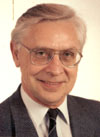
for his pioneering and wide-ranging contributions to Earth and solar system sciences, his leadership in the initiation and promotion of space programmes, and his important role in the development of the Society
Sir lan Axford has had an enormous impact on solar-terrestrial sciences with major scientific contributions to magnetospheric, ionospheric and solar and heliospheric physics. In addition he has shown great leadership qualities and has played a significant role in international organisations such as COSPAR and EGS.
Axford and Hines were the first to suggest that magnetospheric-ionospheric convection driven by coupling to the solar wind could drive a diverse range of magnetic and ionospheric phenomena. Axford championed the Dungey magnetic reconnection model when it was established that the direction of the interplanetary magnetic field was an important factor in solar wind-magnetospheric interactions.
Axford was also the first to suggest that there might be a supersonic outflow of light ions from the polar ionosphere, the polar wind. Such a concept was confirmed by Banks and Holzer and fully verified through experiment, though the original ideas proved to be rather simplified due to the presence of wave-particle and other heating and acceleration processes.
Axford’s contributions to solar and heliospheric physics include investigations of the relationship between structure in the solar atmosphere and the outflow of the solar wind. He has also made significant contributions to our understanding of minor ion acceleration in the solar wind, and to the nature of the heliopause. In association with this work, Axford studied the origin and acceleration of cosmic rays. In particular, he deduced that the cosmic ray spectrum could result from multiple interaction with shock waves.
Few have covered such a wide range of fields in solar-terrestrial physics and have provided so many outstanding achievements in these areas. However, in addition to his scientific skills, Axford has shown great flare as an administrator.
As an administrator of the Max-Planck-Institut fiir Aeronomic, Axford has shown great leadership skills and has tirelessly championed new experimental ventures, such as EISCAT, Ulysses and SOHO, and gained the Institute a world-class reputation in the area of solar-terrestrial physics. Recognition of his abilities to lead and to stimulate scientific research resulted in him becoming a popular president of both the EGS and COSPAR.
Among the many awards given to Sir lan Axford are the RAS Chapman Medal, the John Adam Fleming Medal of the AGU, his election as a Fellow of the Royal Society and his knight bachelor of Her Majesty’s Government and the British Commonwealth of Nations.
R. Harrison
Newsletter 59, 33, 1996